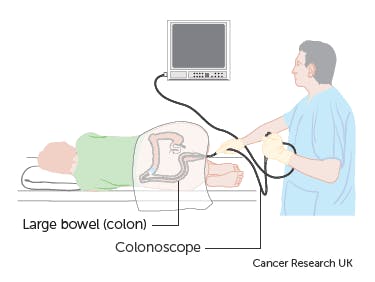Colonoscopy
Colonoscopy is a procedure that enables the doctor to view the entire large intestine with the help of a device called colonoscope. Colonoscope is a long, firm and flexible tube that has a tiny light and camera at its tip. The tip of the colonoscope is put in through the anus and into the rectum and colon. It transmits an image of the lining of the colon so that doctor can examine it for any abnormality.
It is a best method available to diagnose and treat abnormalities within the colon. The majority of colonoscopies are performed as part of screening programs to diagnose colon cancer. The procedure lasts for approximate 30-60 minutes.
Why is it done?

Colonoscopy is commonly used to evaluate gastrointestinal symptoms such as rectal and intestinal bleeding.
It is also used to screen for colon polyps or colorectal cancer. If abnormal areas are seen during the colonoscopy, a biopsy may be obtained. It prevents colorectal cancer, by finding and removing polyp before they turn into cancer.
It can also be used to explore the cause of unexplained diarrhea, weight loss and chronic constipation. It is most often done to investigate the cause of abdominal pain.
Preparation
Before the procedure, you need to talk to your doctor about any medications you are taking including over-the-counter drugs or supplements. Be sure to ask whether you should take them on the day of the test. You may be asked to stop taking them for several days before the test.
You need to follow a liquid diet for atleast a day before the test. The colon and rectum must be clean so the doctor can see the entire lining during the test. This is referred to as “bowel prep.” There are different ways to do this. Doctor may give you a laxative to take the night before your appointment or he may prescribe an enema. If your doctor prescribes a laxative, it will be either a pill or a powder that you mix with water. Some people will need to drink a large amount of liquid laxative over a scheduled amount of time.
You should arrange a friend or family member to drive you home as the anesthesia or sedative need time to wear off. These instructions should be followed as exactly as prescribed or it may have to be repeated.
How a colonoscopy works?
Before a colonoscopy, pain medication and a sedative will be given to you through an intravenous line to limit the discomfort. You will be asked to lie on your left side with the knees drawn up towards your chest while the doctor inserts a colonoscope through your anus and up into the colon.
A small amount of air is used to expand the colon so the doctor can see the colon walls. The colonoscope captures an image on a monitor, allowing the doctor to examine your large intestine. He may ask you to move several times on the table to adjust the scope for the better viewing. You might feel mild cramping during the procedure. Try taking slow, deep breaths to ease the pain. The colonoscope is then slowly withdrawn while the lining of the bowel is carefully examined. The procedure takes about 30-60 minutes to complete.
If colon polyps are found during a colonoscopy, they are removed and sent to the lab to determine if the polyp is cancerous. The majority of polyps are benign and do not become cancerous. This usually does not cause pain but bleeding may occur at the site where the tissue is removed.
After procedure
You will stay in the recovery room for an hour or two until the effect of medications wear off. You may feel cramping in the abdomen and bloating for the first hour after the procedure. This is normal and will be relieved with the passage of gas. You should expect a full recovery and return to normal diet by next day.
If biopsies were taken during the procedure the results will typically be available within a few days.
Risks/complications
Rarely, the colonoscope may puncture the colon wall, and the surgery may be required to repair the hole.
Bleeding: If a polyp is removed or the biopsy is done, you might notice some blood in your stool for the day or two after the test. This bleeding is normal and doctor can treat it right away.
Other potential complication involves reaction to the sedatives used.
DISCLAIMER
This web page provides general information and discussions about health, medicine and related subjects. The information and other content provided on this website, or in any linked materials, are not intended and should not be construed as medical advice, nor is the information a substitute for professional medical expertise or treatment.
The content is for information purpose only and is not a medical advice. Qualified doctors have gathered information from reputable sources; however Credence Medicure Corporation is not responsible for errors or omissions in reporting or explanations. No individual should use the information, resources and tools contained herein to self diagnose or self treat any medical condition.
If you or any other person has a medical concern, you should consult with your health care provider or seek other professional medical treatment. Never disregard professional medical advice or delay in seeking it because of something that have read on this blog or in any linked materials. If you think you may have a medical emergency, call your doctor or emergency services immediately.
The opinions and views expressed on this blog and website have no relation to those of any academic, hospital, health practice or other institution. Credence Medicure Corporation gives no assurance or warranty regarding the accuracy, timeliness or applicability of the content.
